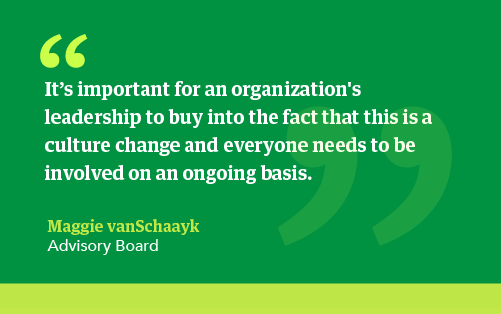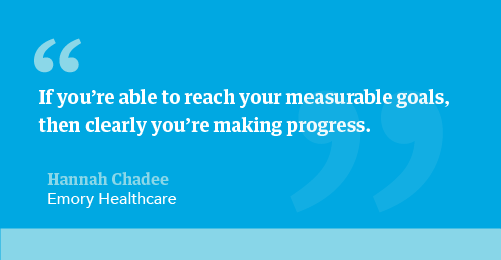In recent years, many organizations around the country have taken steps to increase diversity and inclusion in their workplace cultures. Some are expanding their already robust programs, while others are just starting. Creating an equitable workplace will take time. However, engaging your staff and asking the right questions can help determine where to focus your efforts.
If you want to increase your organization’s diversity, equity, and inclusion (DEI) initiatives, here are some questions to consider to create meaningful change — regardless of where you are in your journey.
What is your organization doing already? Where is change needed?
Identifying where your organization is currently in its DEI journey can help you better plan for the future.
Russ Peal, director of workforce recruitment and retention at the Veterans Health Administration, recommends getting input from current employees at every level of the organization on what a diverse workplace looks like.
“I think it begins with understanding where you are currently as an organization on the diversity, equity, and inclusion scale. The best way to determine that absence of data is to get a sense from your committed staff of how they view things, see things, have experienced things,” he says. “This gives everyone, I think, a collective ownership in creating this diverse and inclusive culture.”
“Often, organizations focus on implementing programs and training,” says Maggie vanSchaayk, a researcher at Advisory Board. “But it’s important for them to buy into the fact that this is a culture change that everyone needs to be involved in on an ongoing basis. Facilities should consider creating a forum for employees to provide input on diversity and inclusion strategy that leaders ultimately go after.”

Tapping into employee resource groups, creating culture roundtables, and encouraging leaders to lean into difficult conversations will help your organization better understand the experiences and ideas of your underrepresented staff — and give you data to set goals and plan the next steps.
“From there, leaders can make changes to, for example, their hiring or succession planning processes, to be more inclusive,” vanSchaayk says.
Do it yourself: 6 ways to develop an authentic DEI program for your healthcare organization
Do you have diverse representation in leadership?
While diversity throughout the entire organization is important, it needs to be represented within the C-suite. According to Jessica Reynolds, candidate experience manager at ChenMed: “People need to see the representation in leadership roles so they know there is opportunity there and that the diversity, equity, and inclusion efforts are genuine.”
Harvard Business Review notes companies that focus on diversity from the top down have a better understanding of their customers, can attract and retain top talent, and are more innovative and successful in the long run. Still, many leadership teams lack diversity.
“For any organization, I don’t think they’ll be able to see diversity in the leadership ranks if there is no succession management process in place,” says Micha’le Simmons, lead Advisory Board researcher. “Plan out which leaders you’re at risk of losing and ensure that who you are grooming for those positions represents the diversity you want to see in your leadership ranks.”
How can you help staff and leaders educate themselves on diversity and inclusion?

Unconscious bias training is the first step to help leaders and staff become more inclusive. Conversations about diversity, equality, and inclusion must continue beyond initial training. For example, after CHG Healthcare CEO Scott Beck asked Black employees how he could do better as a white leader, he shared his blind spots with the company and empowered other leaders to have similar discussions.
“The conversations forced me to leave my comfort zone as I’ve worked to listen and understand this problem in our country at a much deeper level,” Beck says.
CHG leaders were also given resources (podcasts, YouTube videos, articles, and more) to drive conversations about racism. They were encouraged to listen to their employees to better support them and their diverse needs.
Identify best practices: Addressing bias and strengthening diversity in the healthcare workplace
Are you overlooking qualified candidates?
In 2010, 18% of Mercy Health’s workforce was non-white. By focusing on the skills needed for each job, standardizing interview questions, and deciding how screenings will impact hiring decisions, the organization was able to limit the impact of unconscious bias in the hiring process to build a more diverse staff.
“Rather than basing the hiring decision solely on the hiring manager’s view, they are using multiple data points to inform the hiring decision,” explains vanSchaayk.

According to Advisory Board research, the hospital partnered with a consulting firm and used the Department of Labor’s O*NET database to determine skills needed for jobs across the company. They then created standard guides and questions for hiring managers to ask consistent interview questions and make objective hiring decisions. As a result, the percentage of non-white employees grew to 30% by 2015.
Does your workforce match your patient community?

Diversity looks different from community to community, but one core truth remains — representation matters. According to the American Hospital Association
To help you recruit diverse populations of providers, you need to be familiar with different communities within your area, says Hannah Chadee, director of physician talent management at Emory Healthcare. “You want to recruit diversity, so you need to know where potential candidates want to be involved. Is there a mosque or a temple? What is available in my community for the diverse population I want to attract?”
This assessment checklist from AHA can help determine if your staff matches the diverse population of your patients. Census data can also give you a deeper understanding of your community’s makeup and guide you as you make plans to diversify your workplace and create more equitable care.
Are you committed to long-term change?
While some initiatives may take longer than others to see tangible results, setting milestones and measurable goals can help you recognize if you’re moving in the right direction. “If you’re able to reach your measurable goals, then clearly you’re making progress,” says Chadee.

Celebrating how far you’ve come can also be motivating, Chadee continues, especially when you’re “able to reflect and celebrate your milestones and how far you've come. As long as you're moving in the right direction and have those goals, that's a great thing.”
Move in the right direction: Hear insights from healthcare leaders on diversity, equity, and inclusion
CHG can help your organization increase its diversity with the doctors, nurses, and allied professionals you need to provide the best care for your community. Contact us by phone at 866.588.5996.